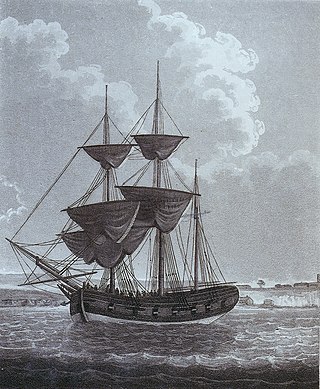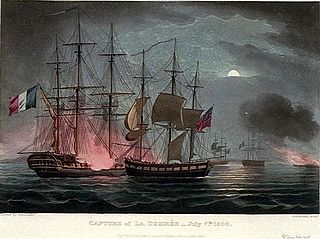
HMS Glatton was a 56-gun fourth rate of the Royal Navy. Wells & Co. of Blackwell launched her on 29 November 1792 for the British East India Company (EIC) as the East Indiaman Glatton. The Royal Navy bought her in 1795 and converted her into a warship. Glatton was unusual in that for a time she was the only ship-of-the-line that the Royal Navy had armed exclusively with carronades. She served in the North Sea and the Baltic, and as a transport for convicts to Australia. She then returned to naval service in the Mediterranean. After the end of the Napoleonic Wars the Admiralty converted her to a water depot at Sheerness. In 1830 the Admiralty converted Glatton to a breakwater and sank her at Harwich.
HMS Leda, launched in 1800, was the lead ship of a successful class of forty-seven British Royal Navy 38-gun sailing frigates. Leda's design was based on the French Hébé, which the British had captured in 1782. Leda was wrecked at the mouth of Milford Haven in 1808, Captain Honeyman was exonerated of all blame, as it was a pilot error.

HMS Monmouth was a 64-gun third rate ship of the line of the Royal Navy, launched on 23 April 1796 at Rotherhithe. She had been designed and laid down for the East India Company, but the Navy purchased her after the start of the French Revolutionary War. She served at the Battle of Camperdown and during the Napoleonic Wars. Hulked in 1815, she was broken up in 1834.
Launched on 21 May 1797, GB No. 21 was renamed HMS Defender on 7 August the same year. She was a 12-gun Courser-class gun-brig built for the British Royal Navy at Limehouse and disposed of in 1802.
HMS Crash was a 12-gun Acute-class gun-brig. She was launched in April 1797 as GB No. 15 and received the name Crash in August. She served against the French and Dutch in the Napoleonic Wars, though after her capture in 1798 she spent a year in the service of the Batavian Republic before the British recaptured her. She was sold in 1802.
HMS Cynthia was a ship sloop of unusual design, launched in 1796. She took part in one medal-worthy boat action and participated in captures of a number of merchant vessels, was present at two notable occasions, the surrender of the Dutch fleet in the Vlieter Incident and the capture of Alexandria, and her crew participated in two land attacks on forts. She was broken up in 1809.

HMS Wolverine, was a Royal Navy 14-gun brig-sloop, formerly the civilian collier Rattler that the Admiralty purchased in 1798 and converted into a brig sloop, but armed experimentally. She served during the French Revolutionary Wars and participated in one action that won for her crew a clasp to the Naval General Service Medal. A French privateer captured and sank Wolverine on 21 March 1804 whilst she was on convoy duty.
During the French Revolutionary and Napoleonic Wars the Admiralty also made use of hired armed vessels, one of which was His Majesty's Hired armed cutter Swan. Actually there were two such cutters, but the descriptions of these vessels and the dates of their service are such that they may well represent one vessel under successive contracts. The vessel or vessels cruised, blockaded, carried despatches and performed reconnaissance.
During the period of the French Revolutionary and Napoleonic Wars, there were two or three vessels known as His Majesty's hired armed cutter Active that served the British Royal Navy. The reason for the uncertainty in the number is that the size of the vessels raises the possibility that the first and second may have been the same vessel.
His Majesty's hired armed cutter Diligent served the British Royal Navy during the French Revolutionary Wars. She was a small vessel, of 44 tons (bm) and six 2-pounder guns, and she served from 27 February 1793 to 1 November 1801.
The Royal Navy employed two vessels designated as His Majesty's Hired armed vessel Sir Thomas Pasley during the French Revolutionary Wars. The two vessels were named for Admiral Sir Thomas Pasley. The vessels are also sometimes described as cutters, but more generally as brigs. The Spanish captured the first Sir Thomas Pasley. The second had a brief, but highly productive, career that later led to her crew qualifying for the Naval General Service Medal. After she was returned to her owners in March 1802, she may have been wrecked in the Mediterranean that same year.
HMS Milbrook was one of six vessels built to an experimental design by Sir Samuel Bentham. After the Royal Navy took her into service in her decade-long career she took part in one notable single-ship action and captured several privateers and other vessels, all off the coast of Spain and Portugal. She was wrecked off the coast of Portugal in 1808.

HMS Eling was one of six vessels built to an experimental design by Sir Samuel Bentham. It is not known when she was launched, though it may have been in 1796. After the Admiralty purchased her in 1798 for the Royal Navy she took part in several campaigns and captured a privateer and other vessels. She was broken up in 1814 after several years in ordinary.

HMS Dart was one of two sloops built to an experimental design by Sir Samuel Bentham and launched in 1796. She served the Royal Navy during the French Revolutionary wars and the early part of the Napoleonic wars before being sold in 1809 for breaking up.
HMS Rosario, previously the Spanish ship Nuestra Senora Del Rosario, was a brig the British Royal Navy captured off Cadiz in 1797 and took her into service. The British converted her to a fireship and expended her in 1800 in an attack at Dunkirk Roads.
HMS Tigress was a Courser-class gun-brig built for the British Royal Navy at King's Lynn, and laid down in 1797 as GB No. 45; she was renamed Tigress on 7 August the same year. She was sold on 20 January 1802.
HMS Princess of Orange was launched in 1796 by the Amsterdam department of the Dutch Navy. In 1799 the British Royal Navy captured her during the Vlieter incident. From 1800 to 1811 she served on the North Sea, Channel, and Irish stations frequently serving as a flagship for various British admirals. Between 1811 and 1820 she served as a powder hulk; she was sold for breaking up in 1822.
HMS Tickler was launched in 1794 as a Conquest-class gunbrig. She was sold in 1802.
The Dutch corvette Waakzaamheid was launched at Enkhuizen in 1786. The French Navy captured her in 1794 and renamed her Vigilance. She was part of a squadron that in 1794 captured or destroyed a large number of British merchant vessels on the Guinea coast. The French returned her to the Dutch, in 1795. The Dutch Navy returned her name to Waakzaamheid. The British Royal Navy captured her without a fight in 1798. She then served as HMS Waaksaamheid until she was sold in September 1802.
HMS Furnace was a Courser-class gunvessel launched in 1797 and sold in 1802.




